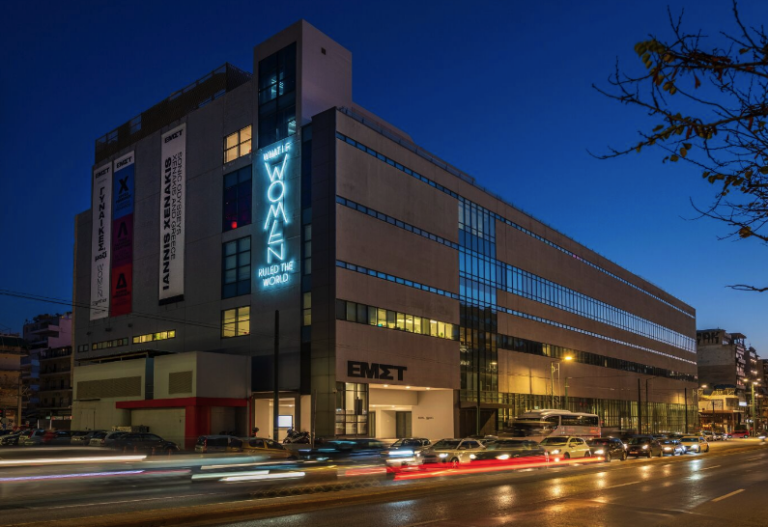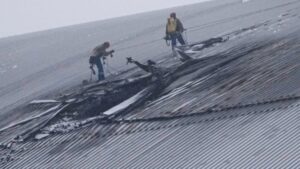With five new exhibitions, which will open on 8 March, the National Museum of Contemporary Art continues its cycle of exhibitions exclusively dedicated to women and artists who identify themselves as feminine, under the broader umbrella title “What if women ruled the world?” (What if Women Ruled the World?), inspired by Yael Bartana’s 2017 neon work of the same name, which adorns the North and South facades of the building, and is visible on the rise and descent of Ave.
The building is located on the Avenue and the Avenue of Syngrou.
This thematic cycle, an initiative of EMST’s (National Museum of Contemporary Art) artistic director Katerina Grego, is based on a repeated hypothetical question: What would happen if the governance of the world had female characteristics?
Would there be less violence? Would we observe more justice in governance? Would this mean an end to wars and armed conflicts and stalemates?
Would human rights be on a better footing? Would economic policy be more equitable and with greater concern for the environment and the world beyond people?
Or would there be the same obsession with profit, regardless of human and environmental costs, and the selfish anthropocentrism that has led us to our current impasses?
Would we see more debate and compromise? And, ultimately, would we experience more caring and empathy in the world? At a time characterized by political polarization and heightened geopolitical tensions, it seems to be an opportune moment to ask this question and also to redress inequalities within the very dominant history of art that for years has marginalized or rendered invisible so many women artists, let alone in a country like Greece where, until now, there has been no organized feminist movement in the visual arts.
At the opening of the exhibitions (08.03.2024), International Women’s Day, at 19.30 & 20.30, Claudia Comte’s performance with the performer Andrea Tortosa Vidal will take place in the foyer of the Museum, as part of Comte’s installation in the foyer of the Museum. At 21.30, Jeanna Criscitiello’s musical performance will take place in the exhibition space on the ground floor.
PROGRAMME
Yael Bartana “What if Women Ruled the World” Front side of the EMST building
08.03-10.11.2024
Curator: Stamatis Schizakis
Yael Bartana Two Minutes to Midnight
08.03.03-27.10.2024
Coordination: Stamatis Schizakis
Yael Bartana has developed an artistic practice over the past twenty years that primarily utilizes video and moving image to examine lesser-known aspects of history as well as incidents that have influenced the formation of collective identities and consciousnesses.
Historical political speeches, demonstrations, activist actions and other events of the present or recent past are recorded, re-enacted or rearranged for the purpose of critical re-examination.
With the same aim and alongside her characteristic audiovisual practice, Yael Bartana creates neon installations where phrases, statements, slogans acquire sculptural substance while being symbols of a still unrealized political vision.
The neon work What if Women Ruled the World (2016) was adapted as a large-scale installation in two languages, Greek and English, on the north and south facade of the Fix building, now posing the archetypal question to passers-by on Syngrou Avenue. In the context of the same theme and in conjunction with the EMST’s exhibition cycle, the video Two Minutes To Midnight, 2021, a 47-minute work based on the two-hour performance in 2017 entitled What if Women Ruled the World?
Here we watch the scenario of a possible nuclear conflict unfold in a setting that is a replica of the set of the 1964 film Dr. Strangelove.
Unlike Stanley Kubrick’s film, the council of the threatened country is made up only of women who have been recognized for their expertise in fields such as defense, peaceful activism, philanthropy, and politics.
In the play we see both a humorous treatment of serious issues, and a practical response to a global threat in an alternative and radically different way from the model of dominant patriarchal power.
Yael Bartana was born in Israel in 1970. She lives and works in Berlin and Amsterdam. During the 1990s she studied in Jerusalem (Bezalel Academy), New York (School of Visual Arts) and Amsterdam (Rijksakademie van Beeldende Kunsten). Her work has been exhibited around the world – including: the Jewish Museum in Berlin (2021), the Stedelijk Museum in Amsterdam (2015), the Secession in Vienna (2012), the Moderna Museet in Malmö (2010) and MoMA PS1 in New York (2008). She has participated in the São Paulo Biennale (2014, 2010, 2006), the Berlin Biennale (2012), Documenta 12 (2007), the Istanbul Biennale (2005) and Manifesta 4 (2002) and has received numerous international awards for her work – including, the Oberhausen International Film Festival Prize (2010), the Anselm Kiefer Prize (2003), and, most recently, the International Female Artists Summit Award (2023).
Her works are included in the collections of major museums such as MoMA in New York, Tate Modern in London, Centre Pompidou in Paris. In 2024 she will represent Germany at the 60th Venice Biennale (together with Ersan Mondtag).
Claudia Comte
The Origin of the Shockwave Ripple Effect (yellow and turquoise)
New production of the EMST
08.03.2024-12.01.2025
Exhibition venue: EMST
Curator: Daphne Vitali
The origin of the shock wave phenomenon (yellow and turquoise), 2024, is a new work by Claudia Comte, especially for the EMST. It is an impressive 30-metre mural that connects the main space of the Museum with the entrance foyer.
The work is a typical example of Comte’s artistic practice, combining traditional craft processes and modern technology, with a vocabulary that evokes organic patterned morphologies.
Comte is known for her in-situ installations, paintings and sculptures that draw on the intricate patterns and shapes inherent in nature, such as waves, sound patterns, cacti and rock formations.
Her murals – created digitally and then executed using vinyl, stencils and painting directly on the wall – are almost like hallucinatory visual feasts that captivate and envelop viewers.
Her work borrows references from popular culture, nature, cultural symbols and artistic movements such as Op Art, Concrete Art and Pop Art. The Origin of the Shockwave Ripple Effect (yellow and turquoise) is typical of the artist’s art practice. The mural is distinguished by a striking ripple effect, creating a dynamic visual movement.
This undulation wraps around a hollow body, creating contrasting perceptions on each side. A colour gradient flowing from turquoise to yellow, ending in white, echoes the vibrancy and diversity of nature.
The origin of the shockwave effect (yellow and turquoise) is an intricate choreography of colours and forms that resonates with the architectural physiognomy of the Museum.
The turquoise horizontal lines mimic the movement of the waves, guiding visitors through the space.
These lines morph into a more linear form as they merge with the yellow band, eventually resulting in a black and white pattern resembling seeds.
The work acts as a metaphor on the impact of human activity on nature, reminding us how even the smallest actions can create ripples of change, just as a drop of water creates infinite waves.
Blurring the boundaries between art, nature and architecture, the work offers visitors a unique visual and sensory experience.
Claudia Comte’s visual research stems from a long-standing interest around the history and memory capture of biomorphic forms through traditional manual practices, as well as industrial and mechanical technologies.
Her on-site (in-situ) installations combine monumental murals and sculptures inspired by organic patterns and morphology, demonstrating the “intelligence” and transformative capacities of the ecological world.
Comte has presented her work in solo and group exhibitions internationally, including the following: Globus Public Art Project/Fondation Beyeler, Switzerland (2023), Foundación Casa Wabi, Puerto Escondido, Mexico (2023), Museum Haus Konstruktiv, Zurich, Switzerland (2022), Desert X AlUla, Saudi Arabia (2022), The Dreamers, Salon 58th October – Belgrade Biennale, Belgrade, Serbia (2021), Museo Nacional Thyssen – Bornemisza, Madrid, Spain (2021); Copenhagen Contemporary, Copenhagen, Denmark (2019); Castello di Rivoli, Turin, Italy (2019). Claudia Comte was born in 1983 in Grancy, Switzerland. She lives and works in Basel.
Hadassah Emmerich Epicurean Eden
New Production of the EMST
08.03.2024
Exhibition space: educational programme space – Mesopatoma
Coordination of artistic production: Yannis Arvanitis
Hadassah Emmerich is known for her colorful, bold, exuberant murals and paintings in which intricately stylized depictions of exotic fruits, human body parts, and natural elements are woven together.
Her work reflects an immersive and instinctive exploration of the body and identity, navigating the realms of the sensual and sensuous while exploring the commodification of desire, the erotic and the exotic.
The sensuality of her paintings is not only found in the surface of the image, but also in her sophisticated use of colour and original, seamless technical execution. Since 2016, Emmerich has invented a new painting technique, using stencils she cuts from vinyl flooring and then covers them with ink and prints them on canvas, paper or wall.
With references to the visual language of advertising and Pop Art, she creates images that focus on the female body, capturing the paradox of simultaneous attraction and repulsion, intimacy and cold detachment, seduction and critical appraisal. For her first presentation in Greece, Emmerich has created a new large-scale mural designed specifically for the EMST, covering part of the ground floor and mezzanine of the Museum and occupying its educational space, radically transforming it into an immersive and colourful Gesamtkunstwerk, ideal for children.
Hadassah Emmerich studied at the Maastricht Academy of Fine Arts, HISK – Higher Institute of Fine Art, Ghent and Goldsmiths College, London. Her recent exhibitions include False Flat, Bonnefanten Museum, Maastricht (2022), AbrasiveParadise, Kunsthal KAdE, Amersfoort, NL (2022), Trailblazers, 150 Years of the Royal Prize for Painting, Royal Palace, Amsterdam (2021), BXL Universel II: multipli. city, CENTRALE Centre for Contemporary Art, Brussels (2021); Buah Tangan, ISA Art Gallery, Jakarta (2020); The Great Ephemeral Skin, De Garage, Mechelen (2019). Hadassah Emmerich was born in Hererlen, the Netherlands, in 1974. She lives and works in Brussels. Her work is in numerous public collections, including.
Lola Flash
SALT
08.03-10.11.2024
Exhibition venue: Second floor
Curator: Ioli Tzanetaki
The EMST announces the first solo presentation in Greece of the internationally acclaimed photographer Lola Flash.
Working at the forefront of queer representation for more than four decades, Lola Flash’s work challenges preconceptions and stereotypes about gender, sexuality and race.
An active member of ACT UP (AIDS Coalition to Unleash Power) during the AIDS epidemic in New York City, Flash was featured in the iconic 1989 poster “Kissing Doesn’t Kill”.
Their art and activism are deeply connected, fueling a lifelong commitment to promoting and preserving the heritage of LGBTQ+ and communities of color worldwide. The SALT series (2011-ongoing) on view at the Museum is a series of portraits depicting important older female figures (over seventy years old) who have had a silent impact on their world and continue to be passionately engaged in their life’s work. In a culture where beauty is identified with youth, these women are not only beautiful but also accomplished and have made significant contributions to society.
This moving series of portraits reflects their wisdom, charm, attractiveness and strength, which is often overlooked due to age prejudice, especially against women.
The subjects of the Salt series include, among others, Tony Parks – photographer and daughter of legendary photographer Gordon Parks, Koho – a masterful sumi-e painter, and renowned activist Esther Cooper Jackson.
The women were photographed where they felt most at home in order to capture the texture of their private space.
SALT aims to challenge social marginalization and invisibility experienced by older women and to highlight the deep-rooted cultural and social biases that remove them from the public sphere.
Flash’s work references the twentieth century tradition of portraiture, using a large 4×5 camera, as she believes this process conveys the importance of sitting for the subject and conveys a truer image.
Lola Flash works as a practicing artist in the US and UK with numerous international exhibitions and commissions over the last four decades. Flash received her bachelor’s degree from the Maryland Institute and her master’s degree from the London College of Printing, UK.
She works primarily in portraiture, dealing with those who are often considered invisible.
Their work is included in major collections, including the Victoria and Albert Museum, MoMA, the Whitney, the Museum of African American History and Culture, and the Brooklyn Museum. Flash is currently a member of the Kamoinge Collective and a member of the Board of Directors of Queer Art.
Malvina Panagiotidi
All Dreams are Vexing
New Production of EMST
08.03-02.06.2024
Exhibition venue: Project Room, 3rd floor
Curator: Anna Mykoniati
The exhibition All Dreams Are Vexing | All Dreams Are Disturbing by Malvina Panagiotidis is the result of the artist’s thorough research conducted in the summer of 2023 in Spetses, in the house where the first Greek painter, Eleni BoukuraAltamoura (1821-1900), was isolated after the premature death of her two children from tuberculosis. During this period Altamura resorted to spiritualism in an attempt to reconnect with her children, leaving behind several legends and a grimoire, a ‘magical’ manuscript of incantations. The EMST’s Project Room 2 is transformed into an immersive setting, a “magical” space where sculptures made of glass, wax and copper intertwine with a video and sound piece.
With an artistic practice that focuses on the intersections of occult modernism, the function of the imaginary and the openness of human behaviour in different socio-political conditions, Malvina Panagiotidi revisits the myth of the “crazy woman in the attic”.
The exhibition is structured through two lines of research, firstly the re-imagining of the house of Bukoura-Altamura as a symbol of warmth and confinement, as a second skin that protects and suffocates her at the same time.
And secondly, the appropriation of symbols from the “magical” manuscript of Boukoura-Altamura, one of the few surviving in Greek literature, and secondly, their reimagining as carriers of memory.
Entering the exhibition, the viewer penetrates the corridors of the house and the mind of Eleni Boukoura-Altamoura.
As the wax sculptures are fired and transformed, the blown glass parts, which allude to breaths, ghosts, energy of an invisible world, symbolize the unspoken and the silenced, while the bronze elements of her sculptural compositions – human organs, tentacles, plant stems, flowers (or all of them together?) – become a constant that keeps us grounded and present in the here and now.
Malvina Panagiotidi was born in Athens where she lives and works.
She studied architecture at the University of Thessaly and the Art in Context postgraduate program at the Universität der Künste in Berlin. He has been awarded the Stavros Niarchos Foundation Artists Support Programme (2018) and the Spyropoulos Prize (2016).
Selected exhibitions: Design Adventures in Crisis, Benaki Museum, Athens (2021), When You Touch About Me, I Think Myself, SIGNS, Istanbul (2020), Gone Today, Here Tomorrow, AnnexM-Megaron of Music, Athens (2019), Constellations in the soil, NEON & Ephorate of Cyclades Antiquities, Athens (2019), Constellations in the soil, NEON & Ephorate of Cyclades Antiquities, The Equilibrists, DESTE Foundation & New Museum, Benaki Museum, Athens (2016), Hypnos Project, Onassis Cultural Centre, Athens (2016), The Predictions of a One-Night King, Chalet Society, Paris (2015), A Monument for the First Homosexual Emancipation Movement, HKW, Berlin (2015). He is a founding member of the group Anacolutha (2022) and the artistic research group Saprophyte (2009).
CLAUDIA COMTE’S PERFORMANCES
How to Grow and Still Stay the Same Shape
Duration: 10′
Dancer: Andrea Tortosa Vidal
Music: Egon Elliut
The fourth in Claudia Comte’s performance series, How to Grow and Still Stay the Same Shape is a playful choreography in dialogue with the artist’s new in-situ mural The Origin of the Shockwave Ripple Effect on the ground floor of the EMST.
Choreographed by the artist herself and performed by Andrea Tortosa Vidal, a dancer at the Ballet Theater in Basel, the movements interpret the elemental life forms expressed in the visual motif of the mural. Drawing on the ancient tradition of imitation, Comte creates an allegory in which the imaginary imitation of natural phenomena aims to create empathy. Through her interpretation, the artist guides us through the rhythmic patterns of natural phenomena that form the universe of her work at the EMST.
In doing so, she places us in a dynamic relationship with the shock waves, light and sensory experiences of flora and fauna embodied in the fluidity of human movement. The music is by long-time collaborator
Comte, Egon Elliut.
JEANNA CRISCITIELLO
…and then there was EVE
8 MARCH at 21.30
…and then there was EVE is a solo musical performance focusing on issues of female identity.
In order to build a layered human experience, an archetype is created through multiple responses from participants, who are asked to name their personal heroine and associate her with an object.
Their heroine (anti-heroine) is any woman whose actions, creations or philosophy have changed their perception of self-activity, and could be anything from a fictional character or family member to a historical figure.
The object, on the other hand, could be a book or artwork, a photograph… Based on these responses, music and text are written and a new narrative is constructed. EVE is ultimately the protagonist of her own story.
The heroines of the performance are a diverse cast: From family members to poet Sophie Podolski, filmmakers Chantal Akerman and Maya Deren, writers Marguerite Duras and Susan Sontag, American Wild West pioneer Calamity Jane, environmental activist Julia Butterfly, architect Denise Scott Brown, painter Alice Neel, or even evergreen literary heroine Pippi Fakidomitis.
Challenging notions of beauty, success and independence and attempting to break taboos around irreverence and insolence, failure, aging, motherhood, vulnerability and addiction, using vocal effects and a performative body language, EVE becomes the center of attention.
The drilling rig sets to work on the deposits of Crete
Underpinning this work is an interest in facts and myths becoming interwoven realities, whether personal or from narratives.
At the same time, the work explores notions of identity, multiplicity, memory, transference, reinvention and resilience.
Jeanna Criscitiello is an American vocal artist based in Brussels who works with music and sound while exploring spoken word compositions shaped through performance.
She signed a contract with the multinational record label MCA at the age of sixteen, participated in Malcolm McLaren’s song “Call a Wave” (from his album, Waltz Darling), while working as an actress and model.
While still a student at Emerson College in Boston, she traveled and later settled in Europe. She has collaborated on recordings with a variety of artists, from Marc Moulin (Telex) to Richard Jonckheere of Front 242.
He has released two solo EPs (Wounded and All the Glory). Her transition to a broader artistic practice begins with the creation of …and then there was EVE. Criscitiello herself composed, arranged, produced and performed all of the music.
Ask me anything
Explore related questions





